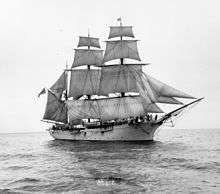USRC Salmon P. Chase (1878)
 USRC Salmon P. Chase | |
| History | |
|---|---|
| Name: | USRC Salmon P. Chase |
| Builder: | Thomas Brown, Philadelphia, Pennsylvania |
| Commissioned: | 6 August 1878 |
| Decommissioned: | 17 July 1907 |
| Fate: | Transferred to the U.S. Public Health Service, ultimate fate unknown. |
| General characteristics | |
| Class and type: | Bark, 3 masts |
| Displacement: | 142 tons (before 1895) |
| Length: | 115.4 ft (35.2 m) (before 1895) |
| Beam: | 24.9 ft (7.6 m) |
| Draft: | 12 ft (3.7 m) |
| Propulsion: | Sail |
| Notes: | School of Instruction training ship |
The USRC Salmon P. Chase was named after Abraham Lincoln's Secretary of the Treasury, Salmon Portland Chase. It was a three-masted bark with a hull length of 106-feet that was designed for use as a training ship for the cadets of the Revenue Cutter Service School of Instruction.
Shortly after the creation of the Revenue Cutter School of Instruction, Revenue-Captain J. H. Merryman, the Revenue Cutter Service's Superintendent of Construction, began work on the design for a school ship to replace the USRC Dobbin. The Chase went into service in the summer of 1878, with its homeport at New Bedford, Massachusetts. Here she served as the Revenue Cutter Service School of Instruction's training ship. She made cadet cruises to Europe, the Azores, the West Indies, and along the eastern coast of the U.S. When in New Bedford, she tied up just above the bridge at the north end of Fish Island, Massachusetts. Here she served as a berthing area for the cadets. The government leased buildings on the north end of the island and used the nearby Mitchell Boat Company buildings for classes, drills, and storage. Most classes, however, were held aboard the Chase which had accommodations for a dozen cadets.
In the late nineteenth century the service briefly enjoyed a surplus of officer candidates, largely because the United States Naval Academy at Annapolis, Maryland was graduating more officers than the navy could employ. In 1890 the Chase was taken out of commission, and for the next four years the Revenue Cutter Service filled the ranks of its officer corps with Annapolis graduates. The 1890s, however, saw an expansion of the Navy, and in 1895 an Act of Congress provided for the retirement of numerous Revenue Cutter Service officers who were too ill or too old to perform their duties. The result was a shortage of junior officers, and a new lease on life for the service's training bark.
The Chase was taken into dry dock, cut in half, and lengthened by forty feet; the new hull section made room for a total of twenty-five cadets. The alterations also seem to have affected the Chase's sailing qualities. Virtually every photograph taken after the rebuilding shows staysails set on the mizzen stays but none on the main.
In its new configuration the Chase remained in service for two more decades, continuing to make practice cruises to Europe, including the port of Cadiz, Spain, in 1904, as well as the east coast ports of the United States. Her last official function was a visit to Hampton Roads, Virginia, for the Jamestown Tricentennial celebration of 1907. Her crew then transferred to the cutter USRC Itasca and the Chase was given to the U. S. Marine Hospital Service where she saw service as a quarantine vessel. At the end of her government career she was refitted and reclassified as a detention barge.
References
- This article incorporates text from the public domain Dictionary of American Naval Fighting Ships.
- U.S. Coast Guard and Revenue Cutters, 1790-1935, Donald Canney, Naval Institute Press, 1995, ISBN 1-55750-101-7